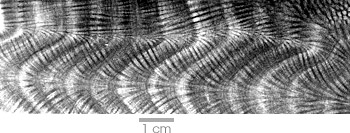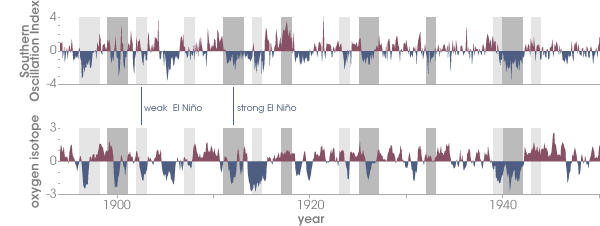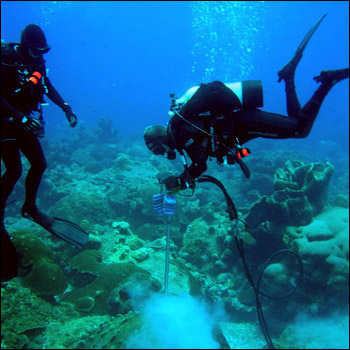

Climate Close-up: Coral Reefs | |||
The warm, shallow ocean waters of the tropics have talkative “forests” of their own. Brightly colored mounds of coral grow in the warm ocean waters, quickly when nutrients are plentiful and more slowly when they are not. Like their land-based counterparts, corals add seasonal layers, which appear as bands in their hard calcium-carbonate shells. Corals respond to small changes in temperature, rainfall, and water clarity in a matter of months, making them a uniquely sensitive climate record. From a small core from the coral, scientists can put together a very detailed picture of climate in the Tropics—significant because much of Earth’s weather is controlled by conditions in the Tropics. |
| ||
 | |||
The bands in the coral’s shell can change in thickness with changes in temperature, water clarity, or nutrient availability, so while each band can record the season’s climate, the interpretation of the record depends on how the three factors are related. Cool water rising from the ocean floor brings extra nutrients in many areas, so the shells are often thicker when the water is cool. In other areas, the cold may slow growth. Scientists have to couple their observations of patterns in the seasonal bands to other measurements, including modern observations of coral growth, to determine what the bands say about climate change. |
Vibrant coral reefs harbor diverse communities of life in the tropical oceans. Like trees, corals produce annual rings that store a record of past conditions. Chemical analyses reveal details about past temperature, nutrient availability, salinity, and other information. (Photograph courtesy NOAA Photo Library) | ||
 |

One of the most significant clues to climate in coral comes from the chemistry of the bands. The chemicals in each layer reflect conditions in the ocean when the layer formed. Like the scaly coverings of foraminifera and other marine organisms, the ratio of heavy and light oxygen in coral growth bands provide a record of temperature and rainfall during the growing season. Both more rain and higher temperatures result in a higher concentration of light oxygen in the ocean. The concentrations of other chemicals can help scientists separate the temperature and rainfall records implied by the oxygen ratio. In coral, the balance between strontium and calcium is largely determined by temperature. By comparing this ratio to the heavy-to-light-oxygen ratio, scientists can more accurately determine whether changes in coral skeletons are because of climate change involving temperature, or ocean salinity, which changes with rainfall, or a combination of both. |
Each of the light/dark bands in this x-ray of a cross-section of a coral core formed during a year of growth. The surface of the coral (grown most recently) is on the left, and older bands extend to the right. (X-ray image courtesy Thomas Felis, Research Center Ocean Margins, Bremen) | |
 | |||
Coral can also tell scientists when heavy rains or floods carried extra sediment into the ocean. Sediment in the water can change the color of the coral as it absorbs elements from the land. Further, reef coral has a symbiotic relationship with algae that use photosynthesis to produce energy. When the water is clouded with sediment, the algae, and therefore the coral, cannot grow as quickly because it doesn’t receive as much sunlight. This slow-down in growth appears in the growth layers pulled from core samples just as drought shows up in the growth rings of trees. The climate record left in coral reefs is detailed, but limited. First, coral reefs don’t exist everywhere in the world. They can only tell scientists about climate in warm, tropical waters. Scientists have discovered some deep water coral that may yield a detailed climate record of other regions, but the work is still in its early stages. Second, coral are living things that die. The record they preserve only covers the lifetime of the individual—a few hundred years, then an older coral from the reef has to be found to stretch the record further back. Piecing together a continuous record can be very difficult and requires numerous samples from both living and fossil corals. |
Scientists use coral cores to study cyclical events like El Niño. The upper graph shows the Southern Oscillation Index—a meteorological measurement of the intensity of El Niño. Low values correspond to El Niño events, high values to La Niña events. The lower graph shows change in oxygen-18 isotopes measured in coral cores on Tarawa Island. The Southern Oscillation Index and the coral oxygen isotope measurements rise and fall together, and they generally match historical records of weak (light gray bars) and strong (dark gray bars) El Niños. (Graphs adapted from Cole, 1993) | ||

Scientists can place the coral reef record in the timeframe recorded by other climate proxies once they know when the reef lived. They can date coral by measuring how much thorium and uranium it contains. Like speleothems, coral contains a large amount of uranium when it forms. Over time, the uranium decays into thorium until there are roughly equal amounts of uranium and thorium—a process that takes about three to four hundred thousand years. From the time the coral forms until the uranium decay evens out a few hundred thousand years later, scientists can tell exactly how old the coral is by measuring how much thorium it contains. This gives them a timeframe to relate to other climate records.
|
These researches are drilling a living coral head in the Flower Garden Banks National Marine Sanctuary, located in the Gulf of Mexico. Records derived from living coral are extended by matching their growth rings with those of fossil corals. Scientists also use carbon-14 and other types of radioisotopic dating to build a chronology from corals. (Photograph courtesy Simone Francis, Texas A&M Ecosystem Modeling Group) | ||